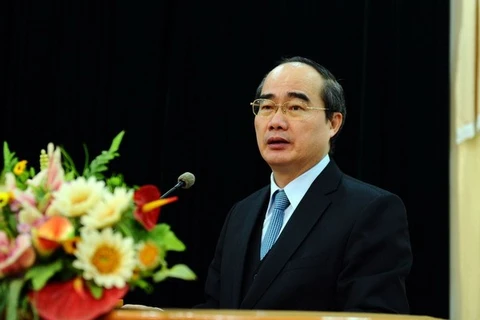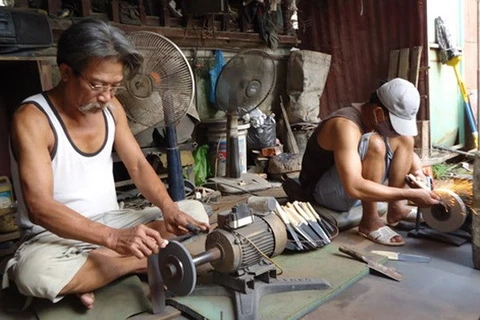Hanoi (VNA) – Van Phuc silk, a famous silk brand from the most ancient weaving village bearing the same name, has been trying to access the international market while still preserve and enrich its cultural identity.
According to Pham Khac Ha, Chairman of Van Phuc Silk Weaving Village Association, in the context of deeper global economic integration, silk producers are trying their best to improve competitiveness, renovating production methods to offer more creative products to meet the demand and taste of both local and international markets.
"However, the difficulty is how to further penetrate foreign markets while still maintaining the village's cultural identity," Ha said.
For three years in a row, the association has been invited by Mekong Institute of Thailand to attend seminars on silk textiles held by Greater Mekong Sub-region (GMS) countries, including Vietnam, China, Myanmar, Laos, Cambodia and Thailand.
In addition, the organisers of the seminars also invited a number of the world's major silk producers such as India, Japan and Australia to participate in the seminars so that the handicraft villages of GMS countries would have the opportunity to study their experiences. Attending the seminar also enables the association to bring their silk products to trade fairs in Thailand, Italy and Russia, Ha said.
Van Phuc silk products presented at fairs were rated to be of high quality and well designed, Ha said, adding that such opportunities enable the association to introduce their silk to foreign customers, attracting tourists to visit the village more regularly and creating tourism development opportunities for the village.
In the village, according to Ha, there are currently 150 stores selling silk and products made from silk. In 2014 alone, the village drew more than 10,000 foreign tourists.
In addition to its achievements, Van Phuc silk was still facing difficulties, Ha said, such as stiff competition from low-quality fake silk imported from China with various designs, eye-catching colours and much cheaper prices.
"This has negatively affected the image and trademark of Van Phuc silk in the eyes of international customers," Ha said.
To address the problem, local leaders have established a high-quality silk introduction centre with a store chain exhibiting and selling Van Phuc genuine silks and unique souvenir items made from silk. The silk products displayed here are regularly examined and strictly controlled, allowing customers to freely shop without worrying about buying fake and shoddy goods, especially foreigners who cannot distinguish genuine products from counterfeit ones, Ha added.
Ngo Thi Thanh Hien, an owner of Van Xuan silk store in the centre said a metre of fake silk costs from 50,000 VND to 80,000 VND (2.20 -3.50 USD), much lower than authentic silk products.
"I sell a metre of Van Phuc silk for about 180,000 VND to 500,000 VND, even 1 million VND for the high-end types. We cannot sell our products at prices that are too low since we have to purchase silk fibre, the material, from the central Highlands province of Lam Dong, not to mention that the process of making a silk cloth requires a lot of effort and meticulousness," Hien said.
Hien noted that foreign visitors often choose their favourite silk cloths to have their dresses or shirts made. They also buy many items such as clothing, blankets, pillows and towels and small items such as bags, purses and handbags as souvenirs.
Kikuchi Yoshihide, a Japanese tourist who has shopped for silk items in Van Phuc village three times, said every time he came back to the village, the designs of the Van Phuc silk products had changed and become more beautiful.
"Japan also produces silk products but they are very expensive. Besides, silk is just used to tailor Kimonos, which are worn only in special occasions. In comparison, Vietnamese silk is much cheaper and its quality is quite good," Yoshihide said, adding that he had bought some silk shorts for himself because he likes its smooth and light weight, and also some scarves as gifts for his friends and family.
Tourism development
Situated on the bank of Nhue river in Hanoi's Ha Dong district about 10km southwest of Hanoi centre, Van Phuc silk village is renowned for its traditional weaving techniques and premium quality of silk products.
According to Ha, under the Nguyen dynasty, Van Phuc silk was considered as extremely precious handiwork used to tailor the dresses of royal family members and aristocrats.
Not only prominent in the domestic market, the traditionally hand-woven and hand-dyed Van Phuc silk has captured the loyalty of customers outside the country. In 1931 and 1932, Van Phuc silk was displayed in international exhibitions for the first time in Marseille and then Paris. At the Paris Fair in 1932, Van Phuc silk was praised by the French as the most sophisticated product from Indochina, Ha recalled.
From 1958 to 1988, the silk was mostly exported to Eastern European markets, Ha added.
With a history of more than 1,200 years, Van Phuc is proud to be the most ancient silk weaving village in Vietnam. The village has been successful in joining craft job preservation with tourism development, Ha said, adding that it has been an amazing destination for handicraft village tourism.
Ha added that restoring traditional craft villages is one of key tasks that Hanoi plans to undertake this year, so Ha Dong district's People's Committee has formulated and implemented a project on the restoration and development of Van Phuc traditional craft village.
Therefore, the village has organised handicraft village tours that enable visitors coming to the village to buy genuine Van Phuc silk products and at the same time, directly visit production facilities to explore the process of making a graceful silk cloth.
Visitors also have the chance to talk with the artisans and learn about the history of a village that has been recognised as the longest-lasting traditional handicraft village in Vietnam.-VNA






















